化工学报 ›› 2020, Vol. 71 ›› Issue (1): 397-408.DOI: 10.11949/0438-1157.20191249
收稿日期:2019-10-23
修回日期:2019-11-15
出版日期:2020-01-05
发布日期:2020-01-05
通讯作者:
黄建花
作者简介:陈克龙(1993—),男,硕士研究生,基金资助:Received:2019-10-23
Revised:2019-11-15
Online:2020-01-05
Published:2020-01-05
Contact:
Jianhua HUANG
摘要:
光生电子-空穴对的快速复合是导致半导体光催化剂性能不佳的重要因素之一,构建异质结是分离光生电子-空穴对的有效方法。结合热缩合和两步水热反应构建了g-C3N4-CdS-NiS2复合纳米管,并进一步研究了在可见光照射下不同CdS含量的g-C3N4-CdS-NiS2分解水制氢的光催化性能。结果表明,当CdS含量为10%(质量)时,三元复合物的产氢速率最高(50.9 μmol·h-1),是纯g-C3N4纳米管的25倍,是g-C3N4-CdS和g-C3N4-NiS2二元复合物的11倍。而且,经过五次循环光催化反应后,产氢速率保持不变。光催化制氢性能的提高主要源于g-C3N4、CdS与NiS2形成的异质结促进光生电子和空穴的迁移及电子-空穴对的分离。
中图分类号:
陈克龙, 黄建花. g-C3N4-CdS-NiS2复合纳米管的制备及可见光催化分解水制氢[J]. 化工学报, 2020, 71(1): 397-408.
Kelong CHEN, Jianhua HUANG. g-C3N4-CdS-NiS2 composite nanotube: synthesis and its photocatalytic activity for H2 generation under visible light[J]. CIESC Journal, 2020, 71(1): 397-408.

图2 CdS、g-C3N4、g-C3N4-0.1CdS、g-C3N4-NiS2和g-C3N4-xCdS-NiS2复合物的XRD谱图
Fig.2 XRD patterns of as-prepared CdS, g-C3N4, g-C3N4-0.1CdS, g-C3N4-NiS2 and g-C3N4-xCdS-NiS2 composites
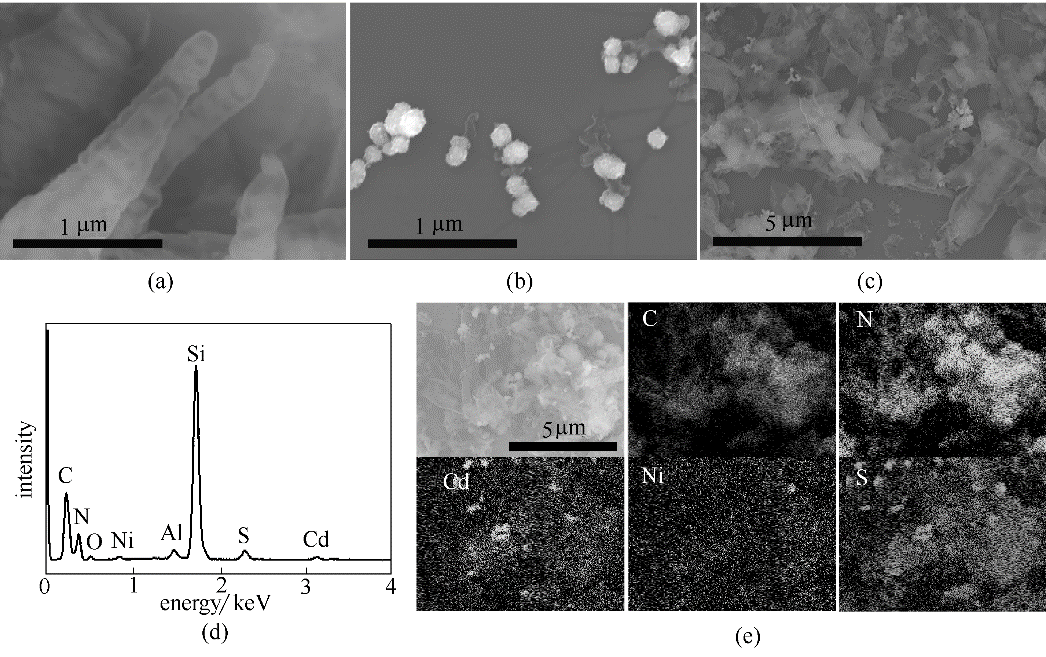
图3 g-C3N4 (a)、CdS (b)和g-C3N4-0.1CdS-NiS2 (c)的SEM图;g-C3N4-0.1CdS-NiS2的EDS能谱图(d)和元素映射图(e)
Fig.3 SEM images of g-C3N4 (a), CdS (b) and g-C3N4-0.1CdS-NiS2 (c); EDS (d) and elemental mapping (e) image of g-C3N4-0.1CdS-NiS2
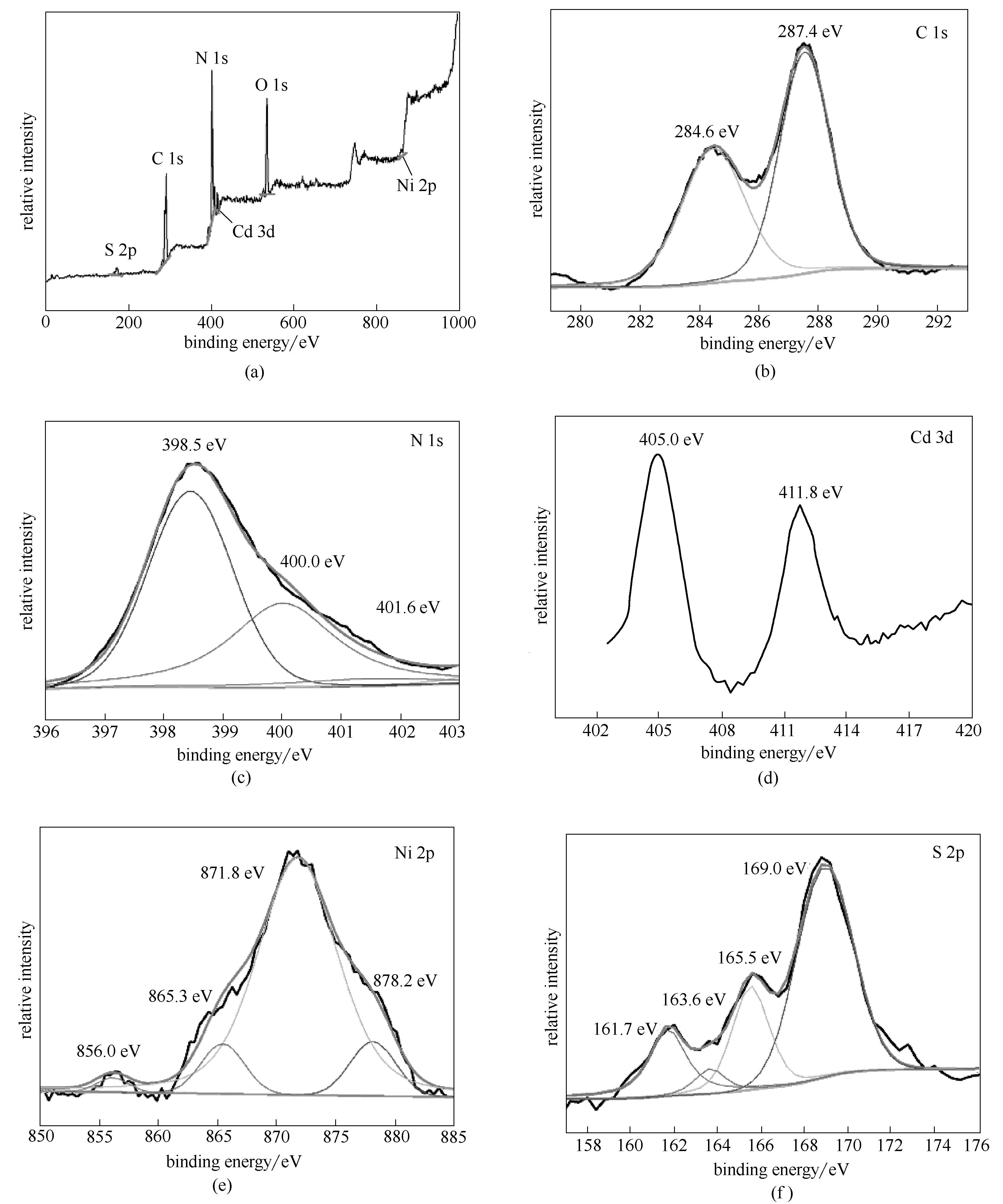
图5 g-C3N4-0.1CdS-NiS2的XPS谱图:全谱(a);C 1s (b);N 1s (c);Cd 3d (d);Ni 2p (e)和S 2p (f)的区域谱
Fig.5 XPS spectra of g-C3N4-0.1CdS-NiS2 composite: survey (a); C 1s (b); N 1s (c); Cd 3d (d); Ni 2p (e); and S 2p (f)

图6 g-C3N4、g-C3N4-0.1CdS和g-C3N4-0.1CdS-NiS2的氮气吸附-脱附等温线(插图为孔径分布曲线)
Fig.6 N2 adsorption-desorption isotherms of g-C3N4, g-C3N4-0.1CdS and g-C3N4-0.1CdS-NiS2 (inset: distribution of pore size)
| 光催化剂 | SBET/(m2·g-1) | 平均孔径/nm | 孔体积/(cm3·g-1) |
|---|---|---|---|
| g-C3N4 | 77.9 | 19.5 | 0.397 |
| g-C3N4-0.1CdS | 73.8 | 18.8 | 0.368 |
| g-C3N4-0.1CdS-NiS2 | 47.1 | 16.8 | 0.247 |
表1 g-C3N4、g-C3N4-0.1CdS和g-C3N4-0.1CdS-NiS2的孔结构参数
Table 1 Pore structure parameters of g-C3N4, g-C3N4-0.1CdS and g-C3N4-0.1CdS-NiS2
| 光催化剂 | SBET/(m2·g-1) | 平均孔径/nm | 孔体积/(cm3·g-1) |
|---|---|---|---|
| g-C3N4 | 77.9 | 19.5 | 0.397 |
| g-C3N4-0.1CdS | 73.8 | 18.8 | 0.368 |
| g-C3N4-0.1CdS-NiS2 | 47.1 | 16.8 | 0.247 |
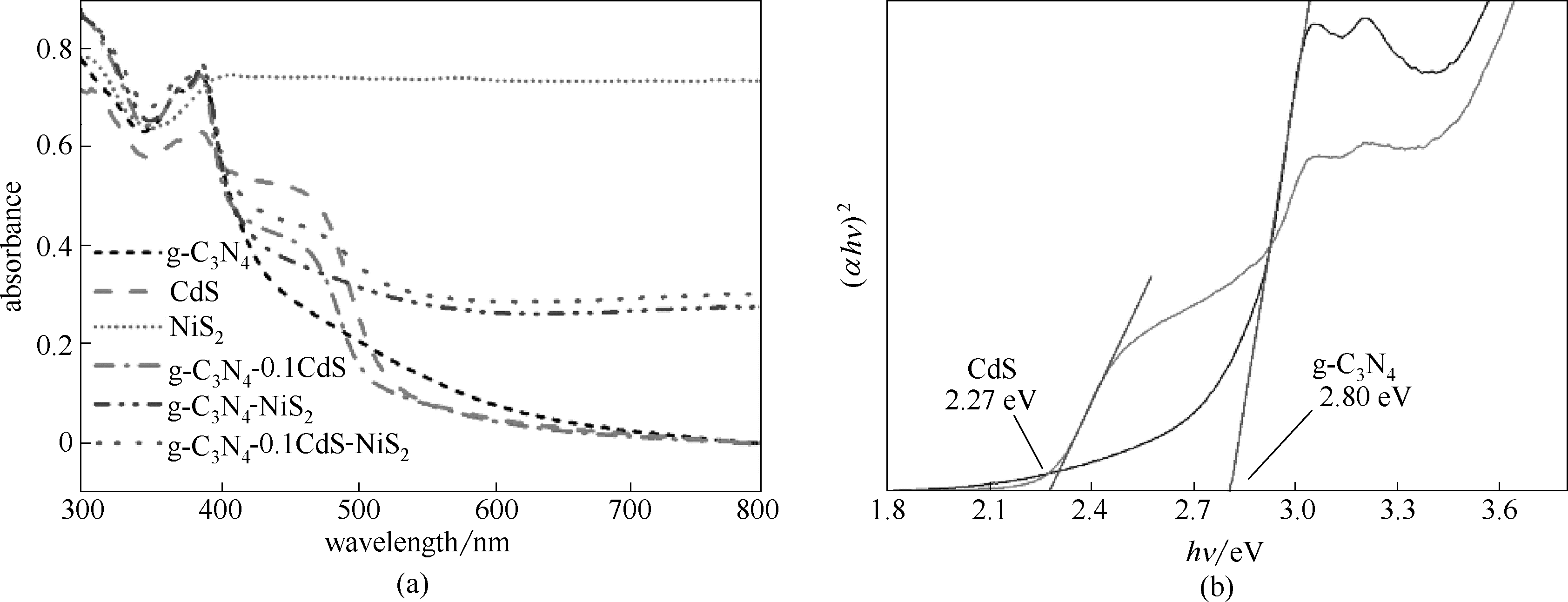
图7 g-C3N4、CdS、NiS2、g-C3N4-0.1CdS、g-C3N4-NiS2和g-C3N4-0.1CdS-NiS2的紫外-可见DRS图(a);g-C3N4和CdS的(αhν)2-hν的Tauc图(b)
Fig.7 UV-vis DRS of g-C3N4, CdS, NiS2, g-C3N4-0.1CdS, g-C3N4-NiS2 and g-C3N4-0.1CdS-NiS2 (a); Tauc plots of (αhν)2-hν for g-C3N4 and CdS (b)
| 光催化剂 | 助催化剂 | 氙灯功率,波长 | 催化剂用量/mg | 性能/(μmol·h-1) | 稳定性 | Ref. |
|---|---|---|---|---|---|---|
| g-C3N4 纳米管/CdS | NiS2 | 300 W,λ>420 nm | 50 | 50.9 | 25 h/100% | this work |
| CdS 纳米棒/g-C3N4 纳米片 | NiS | 300W,λ>420 nm | 50 | 128 | 12 h/80% | [ |
| CdS 纳米棒/g-C3N4 纳米片 | CoP | 300 W,λ>400 nm | 5 | 118 | 20 h/100% | [ |
| 块体g-C3N4 /CdS量子点 | Pt | 300 W,λ>400 nm | 100 | 17.3 | 30 h/100% | [ |
| CdS/g-C3N4 | CuS | 350 W,λ>400 nm | 50 | 57.6 | - | [ |
| g-C3N4纳米片/CdS量子点 | WS2 | 300 W,λ>420 nm | 10 | 11.7 | 20 h/90% | [ |
| g-C3N4纳米片/炭黑 | NiS | 300 W,λ>420 nm | 50 | 18.3 | 12 h/90% | [ |
| CdS/碳量子点 | NiS | 350 W,λ>420 nm | 100 | 144.5 | 15 h/100% | [ |
表2 g-C3N4-0.1CdS-NiS2与部分文献报道的复合光催化剂的产氢速率比较
Table 2 Comparison of H2 production rate between g-C3N4-0.1CdS-NiS2 and some reported composite photocatalysts
| 光催化剂 | 助催化剂 | 氙灯功率,波长 | 催化剂用量/mg | 性能/(μmol·h-1) | 稳定性 | Ref. |
|---|---|---|---|---|---|---|
| g-C3N4 纳米管/CdS | NiS2 | 300 W,λ>420 nm | 50 | 50.9 | 25 h/100% | this work |
| CdS 纳米棒/g-C3N4 纳米片 | NiS | 300W,λ>420 nm | 50 | 128 | 12 h/80% | [ |
| CdS 纳米棒/g-C3N4 纳米片 | CoP | 300 W,λ>400 nm | 5 | 118 | 20 h/100% | [ |
| 块体g-C3N4 /CdS量子点 | Pt | 300 W,λ>400 nm | 100 | 17.3 | 30 h/100% | [ |
| CdS/g-C3N4 | CuS | 350 W,λ>400 nm | 50 | 57.6 | - | [ |
| g-C3N4纳米片/CdS量子点 | WS2 | 300 W,λ>420 nm | 10 | 11.7 | 20 h/90% | [ |
| g-C3N4纳米片/炭黑 | NiS | 300 W,λ>420 nm | 50 | 18.3 | 12 h/90% | [ |
| CdS/碳量子点 | NiS | 350 W,λ>420 nm | 100 | 144.5 | 15 h/100% | [ |
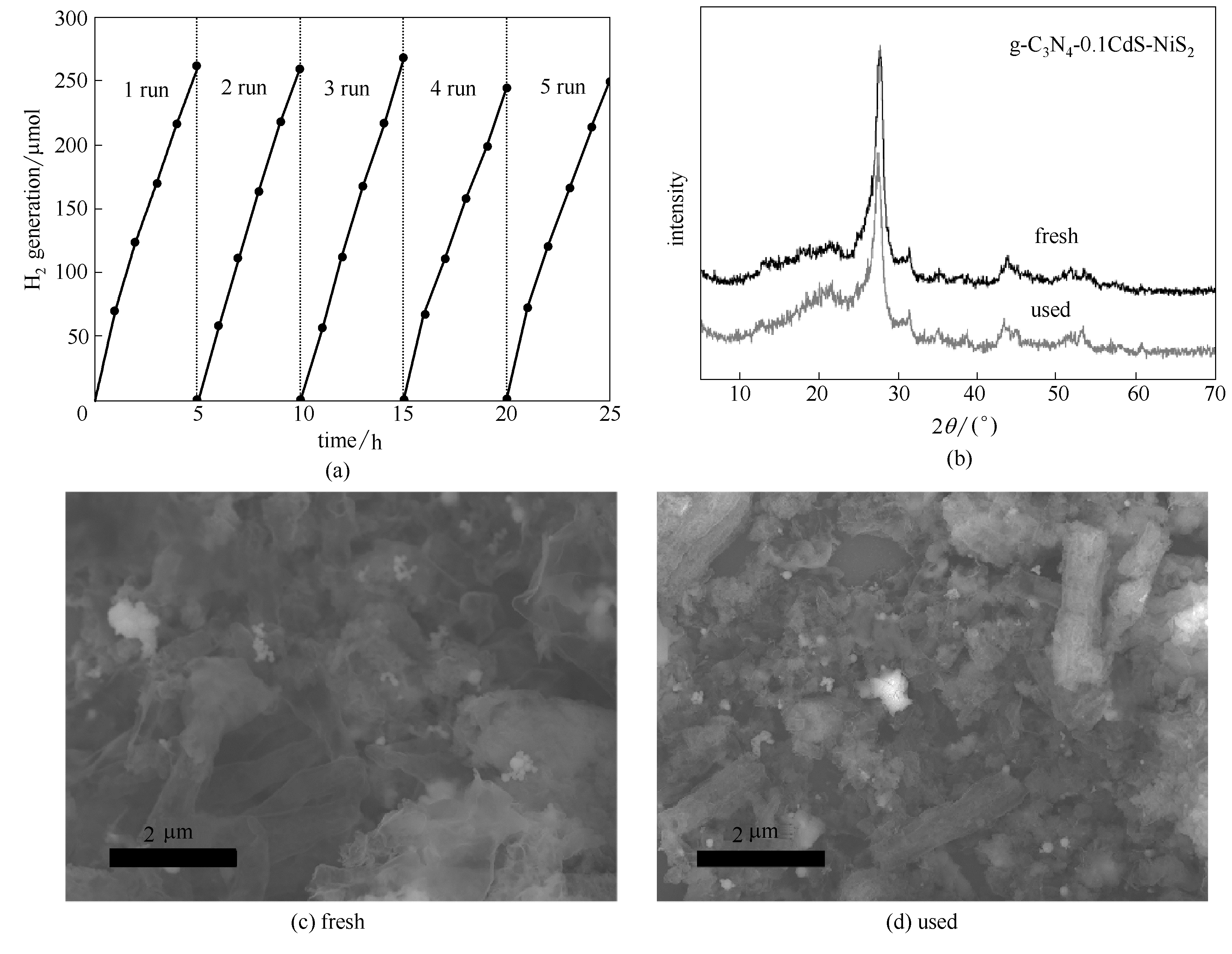
图9 g-C3N4-0.1CdS-NiS2的光催化产氢循环实验结果(a);g-C3N4-0.1CdS-NiS2光催化产氢循环实验前后的XRD谱图(b)和SEM图(c,d)
Fig.9 Cyclic photocatalytic H2 evolution over g-C3N4-0.1CdS-NiS2 (a), XRD patterns (b) and SEM images (c, d) of g-C3N4-0.1CdS-NiS2 before and after cyclic H2 generation

图11 g-C3N4、g-C3N4-0.1CdS、g-C3N4-NiS2和g-C3N4-0.1CdS-NiS2的瞬态光电流响应(a)和EIS Nyquist图(b)
Fig.11 Transient photocurrent response (a) and EIS Nyquist plot (b) of pure g-C3N4, g-C3N4-0.1CdS, g-C3N4-NiS2 and g-C3N4-0.1CdS-NiS2
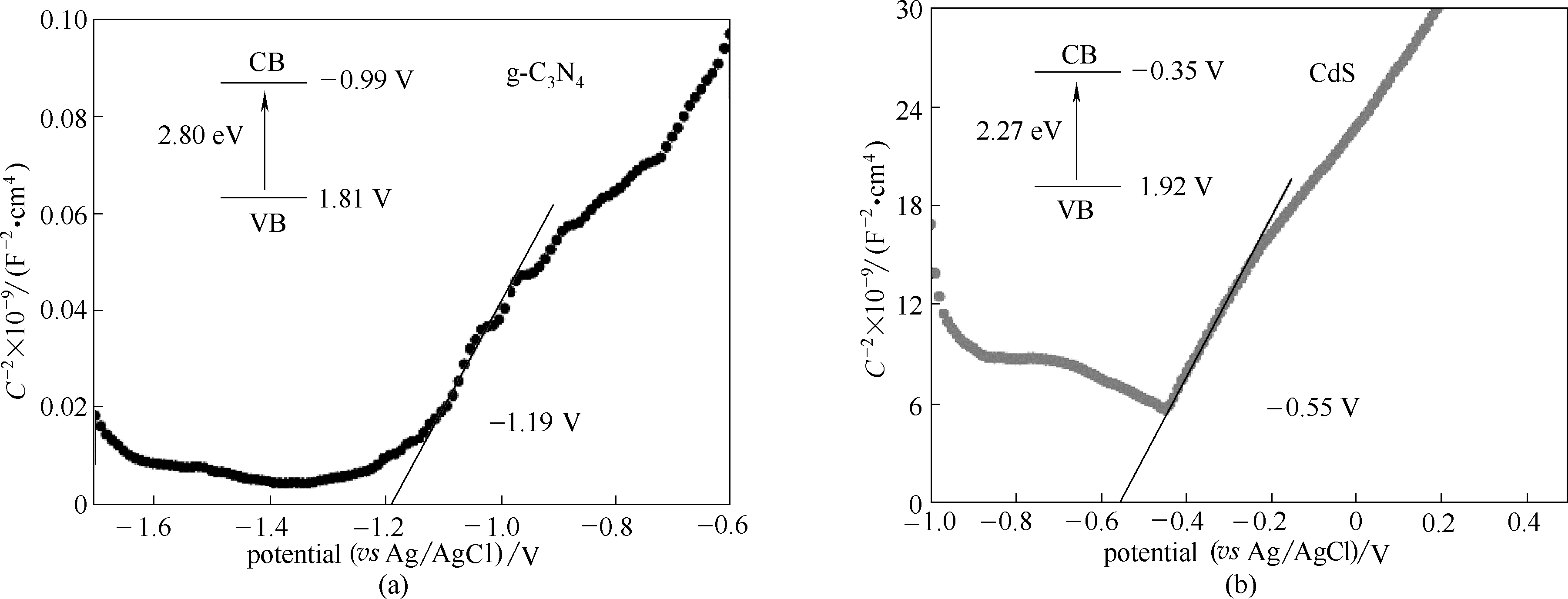
图12 g-C3N4 (a)和CdS (b)的Mott-Schottky图 (插图为CB和VB能级示意图)
Fig.12 Mott-Schottky plot for g-C3N4 (a) and CdS (b) (inset: energy diagram of CB and VB levels)
| 1 | Fujishima A, Honda K. Electrochemical photolysis of water at a semiconductor electrode[J]. Nature, 1972, 238(5358): 37. |
| 2 | Kapilashrami M, Zhang Y, Liu Y S, et al. Probing the optical property and electronic structure of TiO2 nanomaterials for renewable energy applications[J]. Chemical Reviews, 2014, 114(19): 9662-9707. |
| 3 | Li H, Zhou Y, Tu W, et al. State of the art progress in diverse heterostructured photocatalysts toward promoting photocatalytic performance[J]. Advanced Functional Materials, 2015, 25(7): 998-1013. |
| 4 | Yao T, An X, Han H, et al. Photoelectrocatalytic materials for solar water splitting[J]. Advanced Energy Materials, 2018, 8(21): 1800210. |
| 5 | Mamba G, Mishra A K. Graphitic carbon nitride (g-C3N4) nanocomposites: a new and exciting generation of visible light driven photocatalysts for environmental pollution remediation[J]. Applied Catalysis B: Environmental, 2016, 198: 347-377. |
| 6 | Wang X, Maeda K, Thomas A, et al. A metal-free polymeric photocatalyst for hydrogen production from water under visible light[J]. Nature Materials, 2009, 8(1): 76-80. |
| 7 | Xu D, Cheng B, Wang W, et al. Ag2CrO4/g-C3N4/graphene oxide ternary nanocomposite Z-scheme photocatalyst with enhanced CO2 reduction activity[J]. Applied Catalysis B: Environmental, 2018, 231: 368-380. |
| 8 | Liu S, Chen F, Li S, et al. Enhanced photocatalytic conversion of greenhouse gas CO2 into solar fuels over g-C3N4 nanotubes with decorated transparent ZIF-8 nanoclusters[J]. Applied Catalysis B: Environmental, 2017, 211: 1-10. |
| 9 | Zhang P, Deng J, Mao J, et al. Selective aerobic oxidation of alcohols by a mesoporous graphitic carbon nitride/N-hydroxyphthalimide system under visible-light illumination at room temperature[J]. Chinese Journal of Catalysis, 2015, 36: 1580-1586. |
| 10 | Lang X, Chen X, Zhao J. Heterogeneous visible light photocatalysis for selective organic transformations[J]. Chemical Society Reviews, 2014, 43(1): 473-486. |
| 11 | Ong W J, Tan L L, Ng Y H, et al. Graphitic carbon nitride (g-C3N4)-based photocatalysts for artificial photosynthesis and environmental remediation: are we a step closer to achieving sustainability?[J]. Chemical Reviews, 2016, 116(12): 7159-7329. |
| 12 | Inagaki M, Tsumura T, Kinumoto T, et al. Graphitic carbon nitrides (g-C3N4) with comparative discussion to carbon materials[J]. Carbon, 2019, 141: 580-607. |
| 13 | Zhang S, Gu P, Ma R, et al. Recent developments in fabrication and structure regulation of visible-light-driven g-C3N4-based photocatalysts towards water purification: a critical review[J]. Catalysis Today, 2019, 335: 65-77. |
| 14 | 柳璐,张文,王宇新, 等. 石墨相氮化碳的可控制备及其在能源催化中的应用[J]. 化工学报, 2018, 69(11): 4577-4591. |
| Liu L, Zhang W, Wang Y X, et al. Graphitic carbon nitride materials: controllable preparations and applications in energy catalysis[J]. CIESC Journal, 2018, 69(11): 4577-4591. | |
| 15 | Wang S, Li C, Wang T, et al. Controllable synthesis of nanotube-type graphitic C3N4 and their visible-light photocatalytic and fluorescent properties[J]. Journal of Materials Chemistry A, 2014, 2(9): 2885-2890. |
| 16 | Yan S C, Li Z S, Zou Z G. Photodegradation of rhodamine B and methyl orange over boron-doped g-C3N4 under visible light irradiation[J]. Langmuir, 2010, 26(6): 3894-3901. |
| 17 | Zhang J, Hu S, Wang Y. A convenient method to prepare a novel alkali metal sodium doped carbon nitride photocatalyst with a tunable band structure[J]. RSC Advances, 2014, 4(108): 62912-62919. |
| 18 | Wang Y, Li H, Yao J, et al. Synthesis of boron doped polymeric carbon nitride solids and their use as metal-free catalysts for aliphatic C—H bond oxidation[J]. Chemical Science, 2011, 2(3): 446-450. |
| 19 | Wang P, Wu T, Wang C, et al. Combining heterojunction engineering with surface cocatalyst modification to synergistically enhance the photocatalytic hydrogen evolution performance of cadmium sulfide nanorods[J]. ACS Sustainable Chemistry & Engineering, 2017, 5(9): 7670-7677. |
| 20 | Yuan J, Wen J, Zhong Y, et al. Enhanced photocatalytic H2 evolution over noble-metal-free NiS cocatalyst modified CdS nanorods/g-C3N4 heterojunctions[J]. Journal of Materials Chemistry A, 2015, 3(35): 18244-18255. |
| 21 | 何志桥, 陈锦萍, 童丽丽, 等. BiOCl/g-C3N4异质结催化剂可见光催化还原CO2[J]. 化工学报, 2016, 67(11): 4634-4642. |
| He Z Q, Chen J P, Tong L L, et al. BiOCl/g-C3N4 heterojunction catalyst for efficient photocatalytic reduction of CO2 under visible light [J]. CIESC Journal, 2016, 67(11): 4634-4642. | |
| 22 | Gong Y, Wang J, Wei Z, et al. Combination of carbon nitride and carbon nanotubes: synergistic catalysts for energy conversion[J]. ChemSusChem, 2014, 7(8): 2303-2309. |
| 23 | Ge L, Zuo F, Liu J, et al. Synthesis and efficient visible light photocatalytic hydrogen evolution of polymeric g-C3N4 coupled with CdS quantum dots[J]. The Journal of Physical Chemistry C, 2012, 116(25): 13708-13714. |
| 24 | Cheng F, Yin H, Xiang Q. Low-temperature solid-state preparation of ternary CdS/g-C3N4/CuS nanocomposites for enhanced visible-light photocatalytic H2-production activity[J]. Applied Surface Science, 2017, 391: 432-439. |
| 25 | Wen J, Xie J, Yang Z, et al. Fabricating the robust g-C3N4 nanosheets/carbons/NiS multiple heterojunctions for enhanced photocatalytic H2 generation: an insight into the trifunctional roles of nanocarbons[J]. ACS Sustainable Chemistry & Engineering, 2017, 5(3): 2224-2236. |
| 26 | Chen D, Zhao J, Zhang P, et al. Mechanochemical synthesis of metal-organic frameworks[J]. Polyhedron, 2019, 162: 59-64. |
| 27 | Zhao J, Shu Y, Zhang P. Solid-state CTAB-assisted synthesis of mesoporous Fe3O4 and Au@Fe3O4 by mechanochemistry[J]. Chinese Journal of Catalysis, 2019, 40(7): 1078-1084. |
| 28 | Zhao J, Shan W, Zhang P, et al. Solvent-free and mechanochemical synthesis of N-doped mesoporous carbon from tannin and related gas sorption property[J]. Chemical Engineering Journal, 2020, 381: 122579. |
| 29 | Peng W, Zhang S S, Shao Y B, et al. Bimetallic PtNi/g-C3N4 nanotubes with enhanced photocatalytic activity for H2 evolution under visible light irradiation[J]. International Journal of Hydrogen Energy, 2018, 43(49): 22215-22225. |
| 30 | Cao S W, Yuan Y P, Fang J, et al. In-situ growth of CdS quantum dots on g-C3N4 nanosheets for highly efficient photocatalytic hydrogen generation under visible light irradiation[J]. International Journal of Hydrogen Energy, 2013, 38(3): 1258-1266. |
| 31 | Zhao T, Xing Z, Xiu Z, et al. CdS quantum dots/Ti3+-TiO2 nanobelts heterojunctions as efficient visible-light-driven photocatalysts[J]. Materials Research Bulletin, 2018, 103: 114-121. |
| 32 | Chen F, Yang H, Wang X, et al. Facile synthesis and enhanced photocatalytic H2-evolution performance of NiS2-modified g-C3N4 photocatalysts[J]. Chinese Journal of Catalysis, 2017, 38(2): 296-304. |
| 33 | Cao S, Low J, Yu J, et al. Polymeric photocatalysts based on graphitic carbon nitride[J]. Advanced Materials, 2015, 27(13): 2150-2176. |
| 34 | Wu T, Wang P, Qian J, et al. Noble-metal-free nickel phosphide modified CdS/C3N4 nanorods for dramatically enhanced photocatalytic hydrogen evolution under visible light irradiation[J]. Dalton Transactions, 2017, 46(40): 13793-13801. |
| 35 | Zou Y, Shi J W, Ma D, et al. WS2/graphitic carbon nitride heterojunction nanosheets decorated with CdS quantum dots for photocatalytic hydrogen production[J]. ChemSusChem, 2018, 11(7): 1187-1197. |
| 36 | Lu X, Xie J, Chen X, et al. Engineering MPx (M = Fe, Co or Ni) interface electron transfer channels for boosting photocatalytic H2 evolution over g-C3N4/MoS2 layered heterojunctions[J]. Applied Catalysis B: Environmental, 2019, 252: 250-259. |
| 37 | Mishra I K, Zhou H, Sun J, et al. Highly efficient hydrogen evolution by self-standing nickel phosphide-based hybrid nanosheet arrays electrocatalyst[J]. Materials Today Physics, 2018, 4: 1-6. |
| 38 | Pan J, Wang B, Dong Z, et al. The 2D RGO-NiS2 dual co-catalyst synergistic modified g-C3N4 aerogel towards enhanced photocatalytic hydrogen production[J]. International Journal of Hydrogen Energy, 2019, 44(36): 19942-19952. |
| 39 | Shao B, Liu X, Liu Z, et al. Synthesis and characterization of 2D/0D g-C3N4/MoS2/CdS-nitrogen doped hollow carbon spheres (NHCs) composites with enhanced visible light photodegradation activity for antibiotic[J]. Chemical Engineering Journal, 2019, 374: 479-493. |
| 40 | Lin H, Deng W, Zhou T, et al. Iodine-modified nanocrystalline titania for photo-catalytic antibacterial application under visible light illumination[J]. Applied Catalysis B: Environmental, 2015, 176: 36-43. |
| 41 | Di T, Zhu B, Cheng B, et al. A direct Z-scheme g-C3N4/MoS2/SnS2 photocatalyst with superior visible-light CO2 reduction performance[J]. Journal of Catalysis, 2017, 352: 532-541. |
| 42 | Yu H, Zhong W, Huang X, et al. Suspensible cubic-phase CdS nanocrystal photocatalyst: facile synthesis and highly efficient H2-evolution performance in a sulfur-rich system[J]. ACS Sustainable Chemistry & Engineering, 2018, 6(4): 5513-5523. |
| 43 | Ma S, Xu X, Xie J, et al. Improved visible-light photocatalytic H2 generation over CdS nanosheets decorated by NiS2 and metallic carbon black as dual earth-abundant cocatalysts[J]. Chinese Journal of Catalysis, 2017, 38(12): 1970-1980. |
| 44 | Wei R B, Huang Z L, Gu G H, et al. Dual-cocatalysts decorated rimous CdS spheres advancing highly-efficient visible-light photocatalytic hydrogen production[J]. Applied Catalysis B: Environmental, 2018, 231: 101-107. |
| 45 | Yan S C, Li Z S, Zou Z G. Photodegradation performance of g-C3N4 fabricated by directly heating melamine[J]. Langmuir, 2009, 25(17): 10397-10401. |
| 46 | Zhang Y, Peng Z, Guan S, et al. Novel β-NiS film modified CdS nanoflowers heterostructure nanocomposite: extraordinarily highly efficient photocatalysts for hydrogen evolution[J]. Applied Catalysis B: Environmental, 2018, 224: 1000-1008. |
| 47 | He H, Cao J, Guo M, et al. Distinctive ternary CdS/Ni2P/g-C3N4 composite for overall water splitting: Ni2P accelerating separation of photocarriers[J]. Applied Catalysis B: Environmental, 2019, 249: 246-256. |
| 48 | Huang H B, Wang Y, Jiao W B, et al. Lotus-leaf-derived activated-carbon-supported nano-CdS as energy-efficient photocatalysts under visible irradiation[J]. ACS Sustainable Chemistry & Engineering, 2018, 6(6): 7871-7879. |
| [1] | 黄琮琪, 吴一梅, 陈建业, 邵双全. 碱性电解水制氢装置热管理系统仿真研究[J]. 化工学报, 2023, 74(S1): 320-328. |
| [2] | 李艺彤, 郭航, 陈浩, 叶芳. 催化剂非均匀分布的质子交换膜燃料电池操作条件研究[J]. 化工学报, 2023, 74(9): 3831-3840. |
| [3] | 吴雷, 刘姣, 李长聪, 周军, 叶干, 刘田田, 朱瑞玉, 张秋利, 宋永辉. 低阶粉煤催化微波热解制备含碳纳米管的高附加值改性兰炭末[J]. 化工学报, 2023, 74(9): 3956-3967. |
| [4] | 程业品, 胡达清, 徐奕莎, 刘华彦, 卢晗锋, 崔国凯. 离子液体基低共熔溶剂在转化CO2中的应用[J]. 化工学报, 2023, 74(9): 3640-3653. |
| [5] | 陈杰, 林永胜, 肖恺, 杨臣, 邱挺. 胆碱基碱性离子液体催化合成仲丁醇性能研究[J]. 化工学报, 2023, 74(9): 3716-3730. |
| [6] | 杨学金, 杨金涛, 宁平, 王访, 宋晓双, 贾丽娟, 冯嘉予. 剧毒气体PH3的干法净化技术研究进展[J]. 化工学报, 2023, 74(9): 3742-3755. |
| [7] | 范孝雄, 郝丽芳, 范垂钢, 李松庚. LaMnO3/生物炭催化剂低温NH3-SCR催化脱硝性能研究[J]. 化工学报, 2023, 74(9): 3821-3830. |
| [8] | 杨菲菲, 赵世熙, 周维, 倪中海. Sn掺杂的In2O3催化CO2选择性加氢制甲醇[J]. 化工学报, 2023, 74(8): 3366-3374. |
| [9] | 李凯旋, 谭伟, 张曼玉, 徐志豪, 王旭裕, 纪红兵. 富含零价钴活性位点的钴氮碳/活性炭设计及甲醛催化氧化应用研究[J]. 化工学报, 2023, 74(8): 3342-3352. |
| [10] | 杨欣, 彭啸, 薛凯茹, 苏梦威, 吴燕. 分子印迹-TiO2光电催化降解增溶PHE废水性能研究[J]. 化工学报, 2023, 74(8): 3564-3571. |
| [11] | 陈雅鑫, 袁航, 刘冠章, 毛磊, 杨纯, 张瑞芳, 张光亚. 蛋白质纳米笼介导的酶自固定化研究进展[J]. 化工学报, 2023, 74(7): 2773-2782. |
| [12] | 汤晓玲, 王嘉瑞, 朱玄烨, 郑仁朝. 基于Pickering乳液的卤醇脱卤酶催化合成手性环氧氯丙烷[J]. 化工学报, 2023, 74(7): 2926-2934. |
| [13] | 余娅洁, 李静茹, 周树锋, 李清彪, 詹国武. 基于天然生物模板构建纳米材料及集成催化剂研究进展[J]. 化工学报, 2023, 74(7): 2735-2752. |
| [14] | 涂玉明, 邵高燕, 陈健杰, 刘凤, 田世超, 周智勇, 任钟旗. 钙基催化剂的设计合成及应用研究进展[J]. 化工学报, 2023, 74(7): 2717-2734. |
| [15] | 张琦钰, 高利军, 苏宇航, 马晓博, 王翊丞, 张亚婷, 胡超. 碳基催化材料在电化学还原二氧化碳中的研究进展[J]. 化工学报, 2023, 74(7): 2753-2772. |
| 阅读次数 | ||||||
|
全文 |
|
|||||
|
摘要 |
|
|||||
 京公网安备 11010102001995号
京公网安备 11010102001995号
